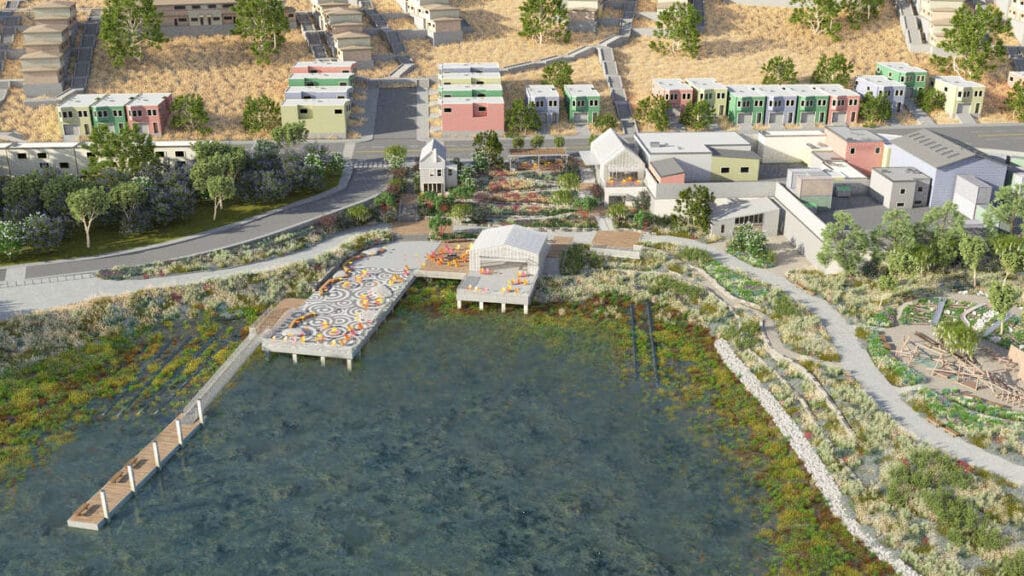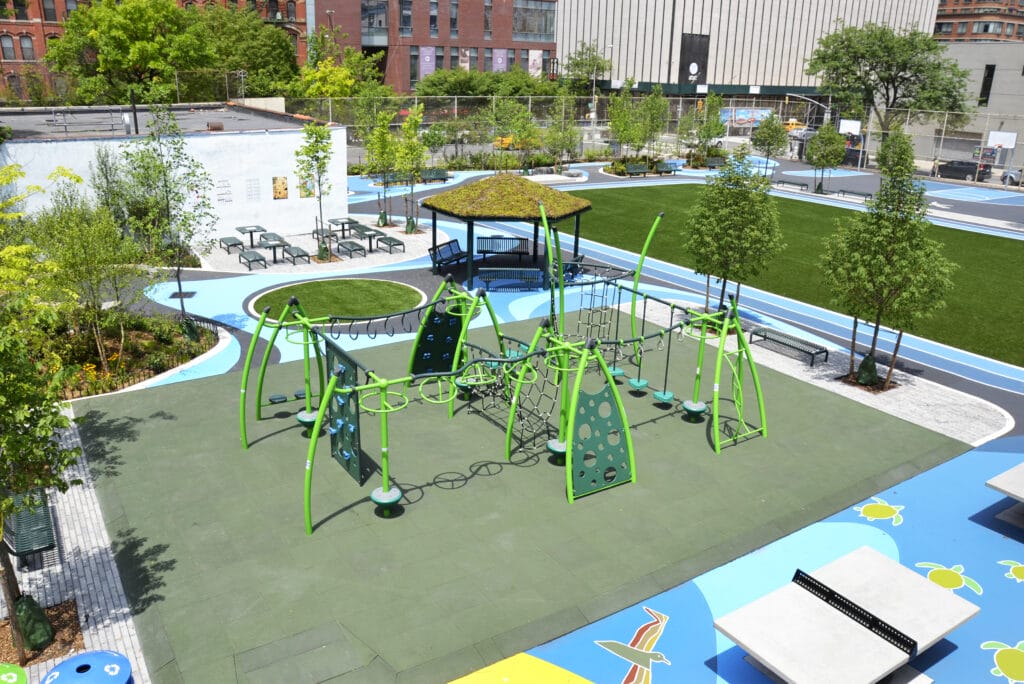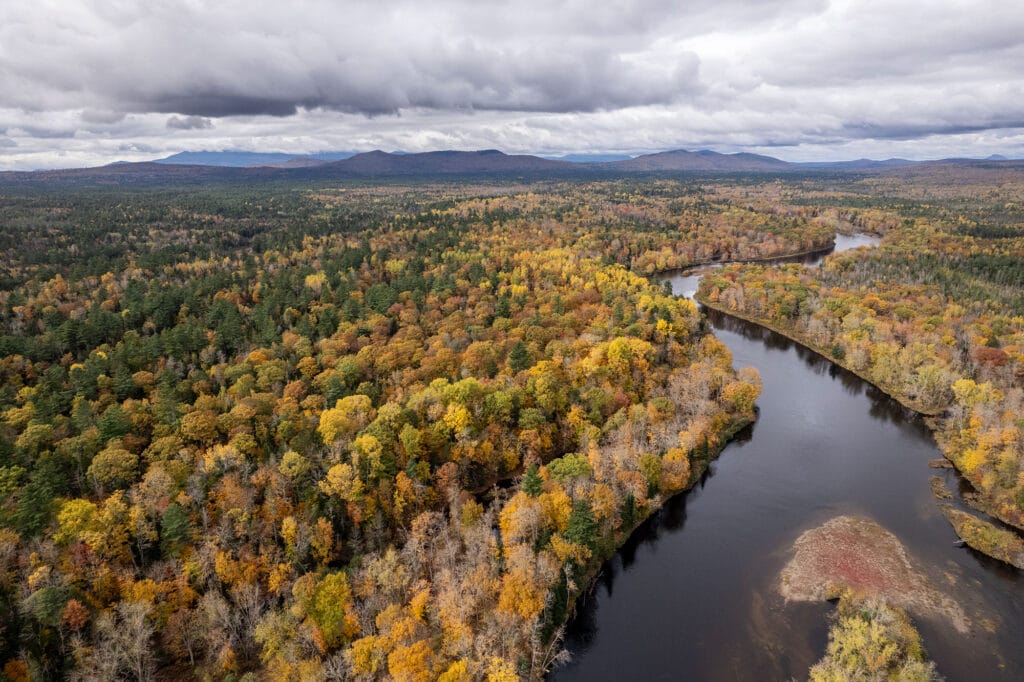Our work has always been measured by more than protected acres or even by the number of people connected to outdoor spaces. Our projects improve communities in ways that can be quantified and ways that can’t. Creating climate resilience, improving social cohesion, driving better health outcomes, and contributing to an overall quality of life—these are the benefits that come from community-led conservation and park creation. These projects stand to deliver all of that and more, but we need your support to bring them across the finish line.
Green Space Championed by Locals — India Basin Waterfront Park
The majority Black Bayview neighborhood in southeastern San Francisco was a prosperous community with thriving shoreline industries in the mid- to late 1800s. But in the several generations since, it has been neglected and under-resourced, and it bears the festering scars of industrial environmental contaminates that cut residents off from the waterfront. Working with the local communities and the San Francisco Recreation and Park Department, we’re helping to create the most ambitious waterfront park in the city’s history. In addition to the park amenities themselves, the project will deliver educational programming and economic opportunities to residents via its Equitable Development Plan.

The park will include miles of winding shoreline trails, acres of restored tidal landscape, and an abundance of recreation opportunities to the heart of the Bayview community. It combines an abandoned industrial site at 900 Innes Avenue with two existing parks that border it.
Upending the Haves-and-Haves-Not Divide in Tacoma — Community Schoolyards®
If you judged Tacoma by world-class Point Defiance Park, you might assume the city is a paragon of public park space. But pull back the lens, and you’ll see that access to and quality of green spaces is unequal in this community where nearly a third of residents do not have a park within a 10-minute walk of home. That’s the largest park access gap of any major city in Washington, and it’s why our partners invited us to help transform five asphalt playgrounds into vibrant, nature-rich play spaces through our Community Schoolyards® program. When the projects are completed, 2,000 students and 25,000 Tacoma residents will have daily access to nature that supports their learning, health, and happiness.

Through the Tacoma Community Schoolyards program, 25,000 residents—2,000 students—will gain access to nature-rich play spaces.
The Greenbelt Set to Bridge Dallas’s Equity Gap — Five Mile Creek Greenway
Five Mile Creek is, literally, a life-giving artery that runs through southern Dallas. And yet nearly half of residents who live within its watershed cannot access its old-growth forests or wildflower meadows within a 10-minute walk of home. By partnering with the city and others, we’ve set a bold vision for creating a 17-mile greenbelt trail that will connect three new parks to 17 existing parks, several hospitals, two colleges, two light rail stations, and nearly 200,000 residents.

Judge Charles R. Rose Community Park will be the next project completed in the Five Mile Creek Greenbelt in Dallas, Texas. When the park is completed, the 3,567 Highland Hills residents who live within a 10-minute walk of it will have a place to exercise and breathe fresh air. The first stage, which features an outdoor classroom and views of downtown Dallas, opens in 2023.
We’re Playing Beat-the-Clock in Marin County — Tiburon Ridge
As we close our 50th year, we have an opportunity to complete a 50-year effort to conserve one of San Francisco’s most significant and precious landscapes. If we can secure the remaining $15 million needed to conserve the property by June 2024, we’ll not only protect grasslands, woodlands, and wetlands that are home to a variety of wildlife, we’ll also help guard against sea-level rise, carbon emissions from new urban development, and the fragmentation of public open space. The views from atop Tiburon Ridge rival any postcard of the Golden Gate Bridge. But it is now zoned for possible future housing development. We have a once-in-a-lifetime chance to save this iconic space. If successful, Tiburon Ridge will be given to the Marin County Parks and Open Space District as a public park for everyone to enjoy.

The hilltop views from the Tiburon Peninsula are guaranteed to rival any postcard of the Golden Gate Bridge.
Largest Land Return in U.S. History — WáhsetəkW
The Penobscot River is so central to the Penobscot people’s culture, they consider it a member of their community, of their family. When they were dispossessed of their native land in the 19th century—including Wáhsehtəkʷ, which we now refer to as the East Branch, the tribe was disconnected from more than the water but also their ancestral way of life. So when this 31,367-acre parcel of land in the Katahdin region became available for sale, TPL acted quickly to step in as a temporary owner. Our goal is to reconnect Wáhsehtəkʷ with the Penobscot Nation, while creating much needed southern access to Katahdin Woods and Waters National Monument.
Together in partnership, TPL and the Penobscot Nation have launched an effort to raise $32 million to protect Wáhsehtəkʷ and the cultural and natural significance it provides. The move is the largest collaborative land return between a U.S. based nonprofit and a tribal nation in recent history.

We are collaborating with the Penobscot Nation to permanently restore nearly 30,000 acres to the Penobscot Nation, while creating much-needed public access to Katahdin Woods and Waters National Monument.
Way Down Yonder . . . the Defining Outdoor Space in Georgia — Chattahoochee RiverLands
We’re leading the effort to create a continuous, multiuse path along the Chattahoochee River, where metro Atlanta’s residents and visitors alike can fish, hike, paddle, and enjoy Georgia’s most famous waterway. We recently took a major step forward as we broke ground on Atlanta’s first ever camp-and-paddle trail, where people can experience 48 miles of the river over four days of paddling. We’ve already preserved 18,000 acres of land and 80 miles of riverfront, but we still have more to do.

We’re creating 100 miles of new trails and parks, connecting 19 cities across seven counties, and building 42 water access points and eight campsites to ensure every person in the metro Atlanta region has access to the benefits and joys of the outdoors.
Giving a New York Railway, Abandoned and Derilect for 60 Years, New Purpose — The QueensWay
In New York’s famed Queens borough, a 3.5-mile stretch of railway once ferried people to the Rockaway Beach Peninsula. For the past 60 years, it has sat decaying and unused. We have the opportunity to revive it into a thriving, vibrant active transportation route for hundreds of thousands of New Yorkers, many of them kids who will enjoy a safer, greener route to and from school. The elevated pathway will connect many Queens communities with 12 schools, 7 subway lines, the Long Island Railroad, and shopping districts. For the 320,000 people who live in high-density neighborhoods within a mile of the QueensWay, this means much-needed public green space, recreation opportunities, and safe commuting routes.

The QueensWay is a chance to provide something for Queens which it otherwise might not get—a long, linear park and recreational trail. It’s the idea of bringing together parks and the outdoors and fitness and green infrastructure and the arts and food all in one continuous public park experience, and giving another reason for people and families to want to live and work in New York.

Donate to become a member, and you’ll receive a subscription to Land&People magazine, our biannual publication featuring exclusive, inspiring stories about our work connecting everyone to the outdoors.

